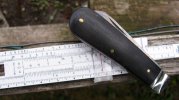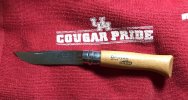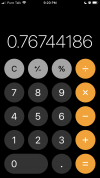Don't you hate it when you hit the wrong emojicon and don't realize it? Glad you're enjoying the thread, Jer!


But you want the right tool for the job. You wouldn't want to remove stems from fresh strawberries with a huge Bowie knife, even though you could; a smaller knife would be a much better choice for that job. Using calculus for Tom's homework is for losers.
Besides, differential calculus is so derivative. (Although folks who get excited about integral bolsters probably can't contain themselves when thinking of integral calculus.)
Piece of string, a ruler, and a calculator seem like the ideal technical tools for this job.



Doing some thinking in a situation in which there's actual right and wrong instead of just expressing an opinion or claiming "But all truth is relative, and THIS is MY truth" is not valued very highly in our society.



Good point! Doing Tom's assignment is FAR easier for me than taking and posting knife photos!


Speaking of expectations, I thought you'd be far more involved in the substance of this thread, Jack!



IIRC, you often write about how too little blade for the size of the handle can be a deal breaker for you. Maybe that's based mostly on your subjective perceptions rather than being data-driven, but wouldn't your argument be even more convincing if it included a quantitative component exactly like Tom's intent?
I think the golden ratio is about 1.618, and its reciprocal, which is more relevant here, is 1/1.618 = .618.
Gotta ask again: Coincidence, ... or Grand Design???
Or maybe because a tang has a
choil (if we want to start a war of weird words)?
I admit there are some unusual technical terms that can be bandied about, but I'll bet that's true in almost any area. (BTW, Vince, I just tell students an annulus is just a washer like you'd use with a bolt and nut, or its a cylinder with a hole bored through the centers of its circular bases.) But it's fun to start a sentence, "Kiss my ___" and fill in the blank with your favorite from azimuth, annulus, pendulum, astrolabe, clinometer, sextant, slide rule, tangent, choil, bolster, tang, liners, etc. and see the reaction of the "general public".
View attachment 2047688
Remember when the Rolling Stones sang,
When I'm driving in my car
When a man come on the radio
He's telling me more and more
About some useless information
Supposed to fire my imagination
I can't get no, oh, no, no, no, hey, hey, hey
That's what I say
I can't get no satisfaction
They were obviously NOT singing about John, who has compiled a bunch of fascinating info in his post. Most of it is not relevant to Tom's homework from a content perspective, but almost everything John included has a fascinating history, whether it's Archimedes' methods for approximating the value of π, or for developing the formulas for volumes of cylinder and cone centuries before the "official" development of algebraic notation and calculus, or the story of the first discovery/invention (lots of philosophical fights over THAT distinction) of the "quadratic formula" by the Islamic mathematician Al-Khwarizmi (from whose name the word "algorithm" comes - another thing you could challenge someone to kiss) who did it all geometrically and actually had several "quadratic formulas", depending on the form of the quadratic equation he was trying to solve (and he published it all in a book whose title include the words "al jabr" from which our term algebra was formed when translated into Latin).
When I read the original post, I'd have never guessed that Mandelbrot's fractal geometry would appear!!


- GT










